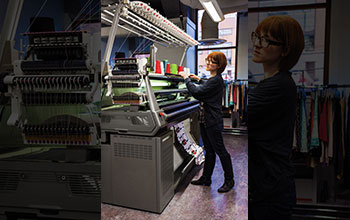Multimedia Gallery
Developing "smart" or electronic textiles
Kristy Jost, a student designer and scientist at Drexel University, works with a computerized knitting machine used to make rapid prototypes of real electronic fabrics. Jost is developing textile supercapacitors using 3-D knitting design and fabrication in the Shima Seiki Haute Technology Lab of Professor Genevieve Dion.
Unlike batteries, a supercapacitor is an energy storage device than can be made entirely of non-toxic materials and has highly reversible charging and discharging cycles, making supercapacitors last for upwards of 1 million cycles. In addition, supercapacitors can charge in a matter of seconds. These devices can be used to power wearable sensors and antennas, or harvest energy from wearable solar panels and other energy harvesting devices.
Jost's interests lie in exploring and creating "smart" or electronic textiles--textiles that feel like regular fabric but can perform tasks such as monitoring the heart rate and blood pressure of the wearer or a jacket that heats up to adjust to the temperature outside.
Jost began her career at Drexel in 2007 as an undergraduate majoring in fashion design. Later, she made the transition from fashion design to a Ph.D. program in materials science and received a National Science Foundation Integrative Graduate Education and Research Traineeship (IGERT) program fellowship. Her graduate research continues to focus on integrating energy storage into textiles using manufacturing methods widely used in the apparel industry. (Date of Image: February 2013)
Credit: Charles Cerrone, Drexel University
Images and other media in the National Science Foundation Multimedia Gallery are available for use in print and electronic material by NSF employees, members of the media, university staff, teachers and the general public. All media in the gallery are intended for personal, educational and nonprofit/non-commercial use only.
Images credited to the National Science Foundation, a federal agency, are in the public domain. The images were created by employees of the United States Government as part of their official duties or prepared by contractors as "works for hire" for NSF. You may freely use NSF-credited images and, at your discretion, credit NSF with a "Courtesy: National Science Foundation" notation.
Additional information about general usage can be found in Conditions.
Also Available:
Download the high-resolution JPG version of the image. (10.4 MB)
Use your mouse to right-click (Mac users may need to Ctrl-click) the link above and choose the option that will save the file or target to your computer.



